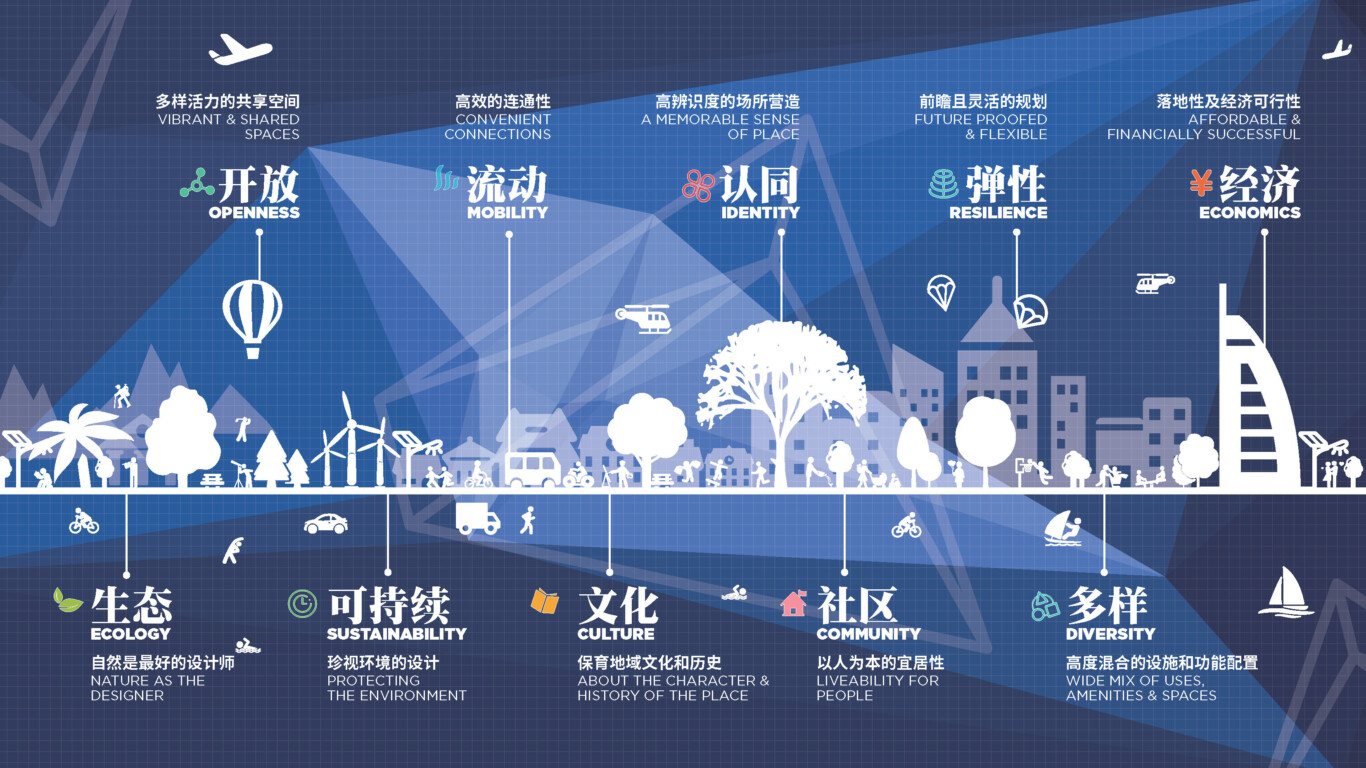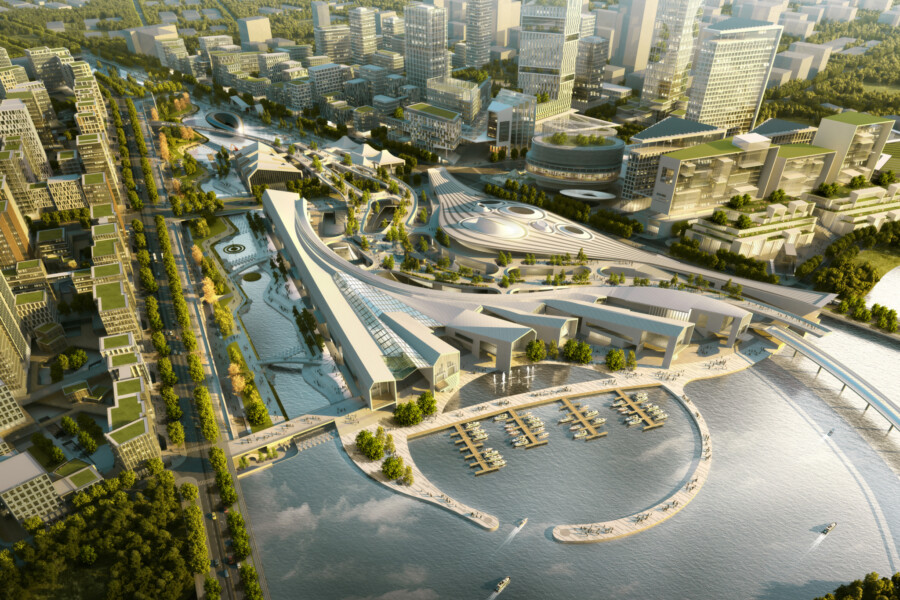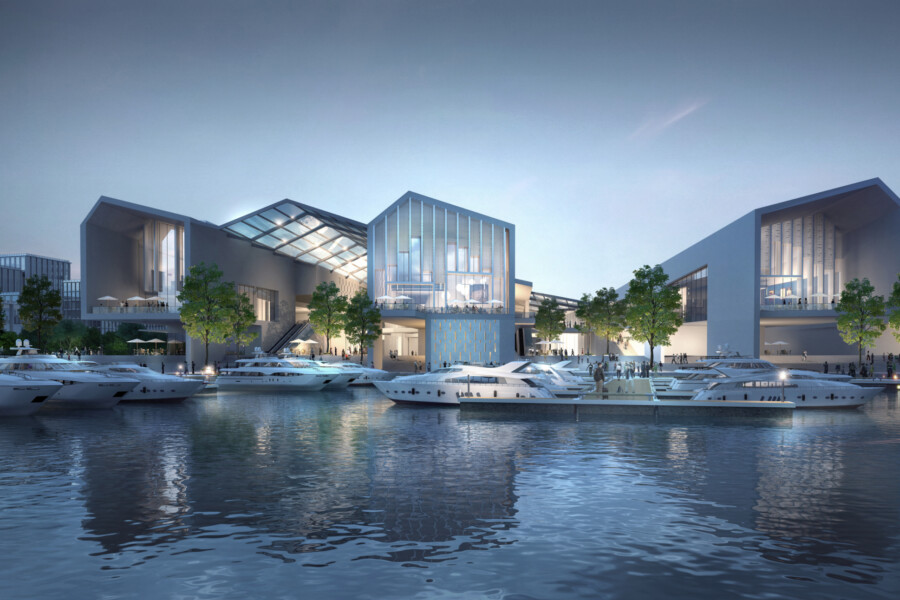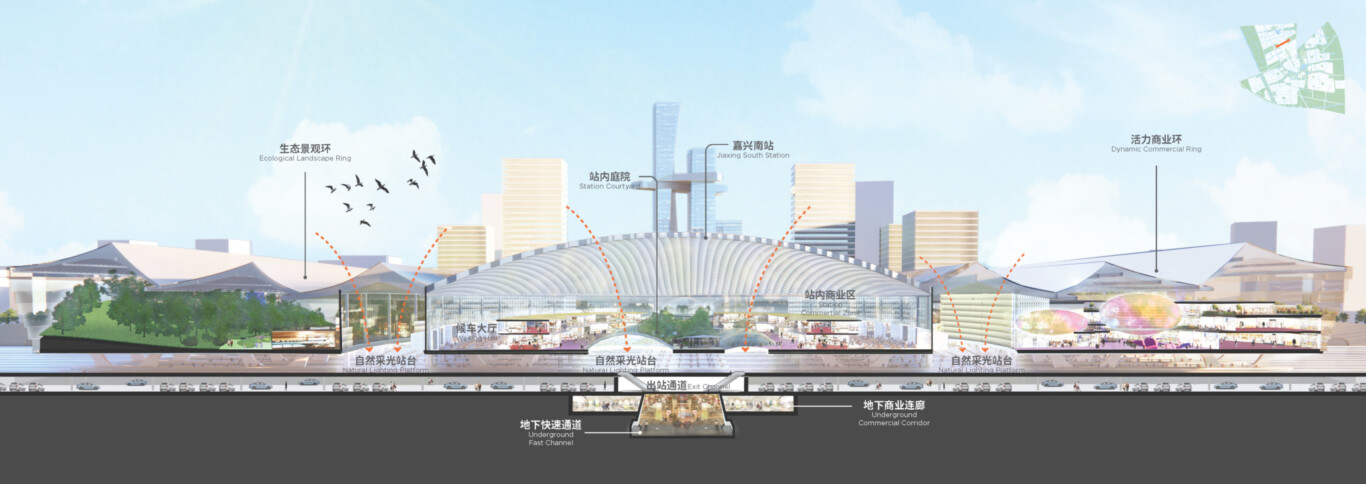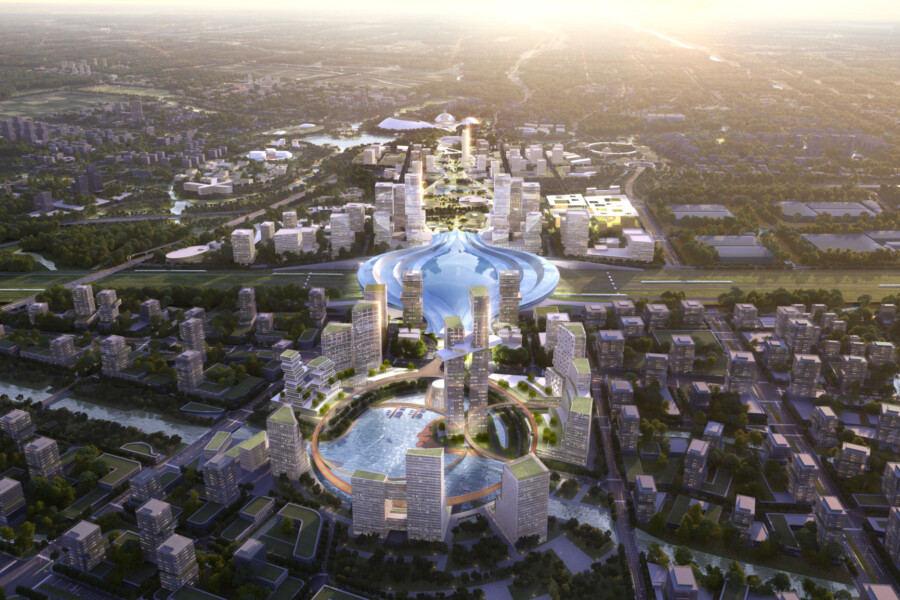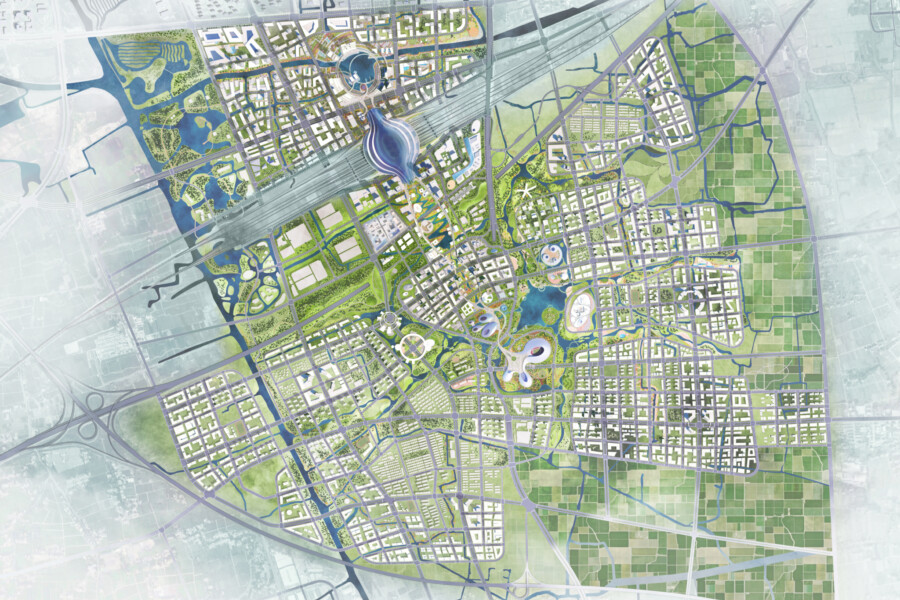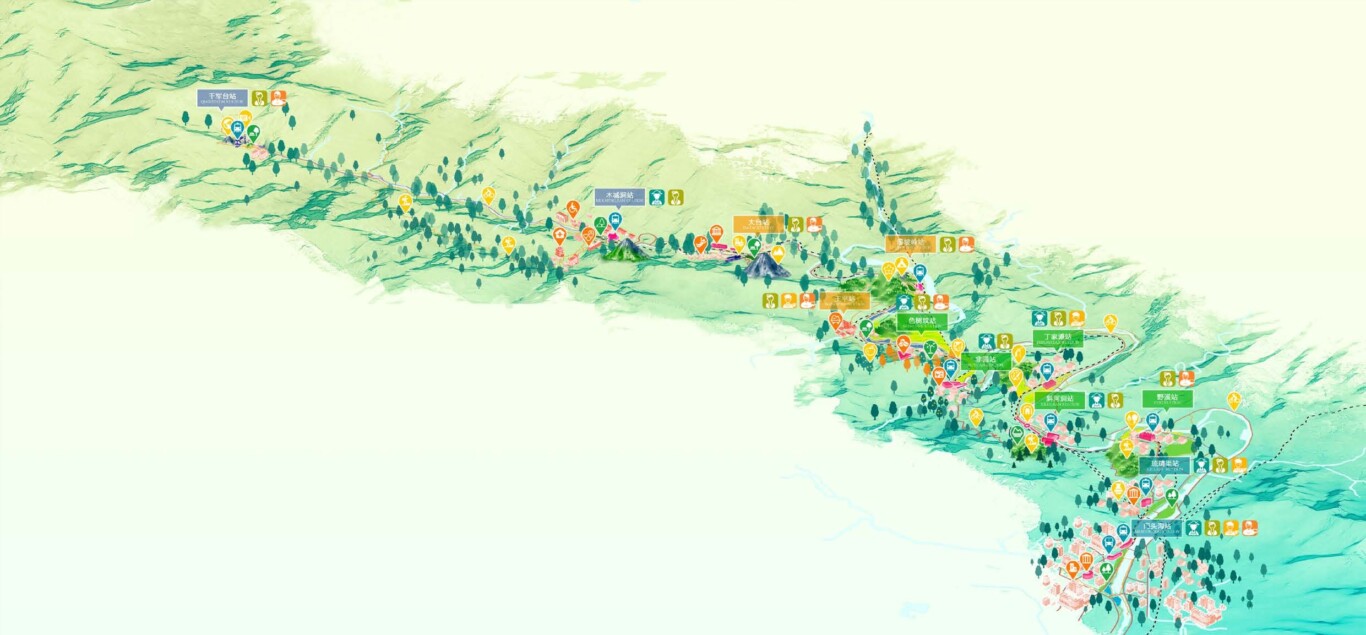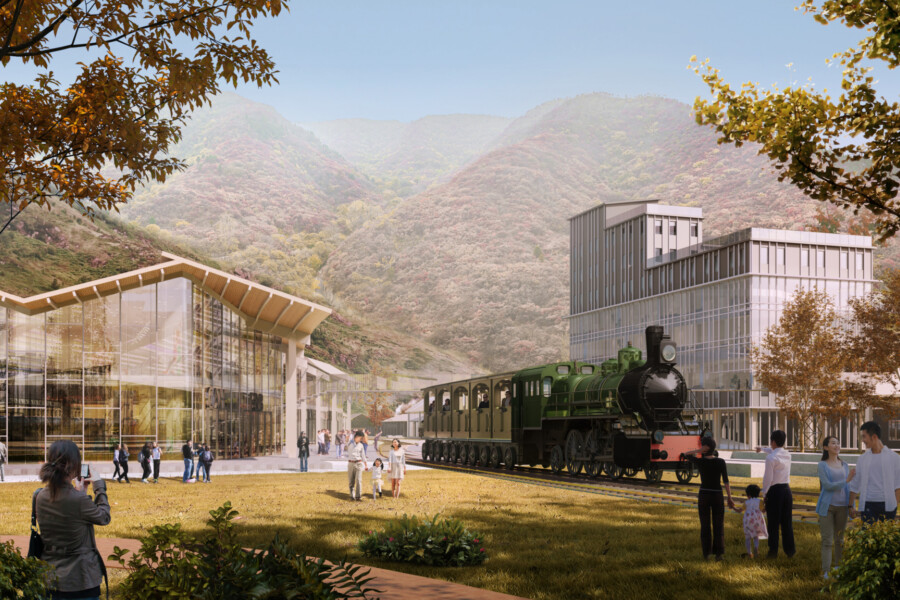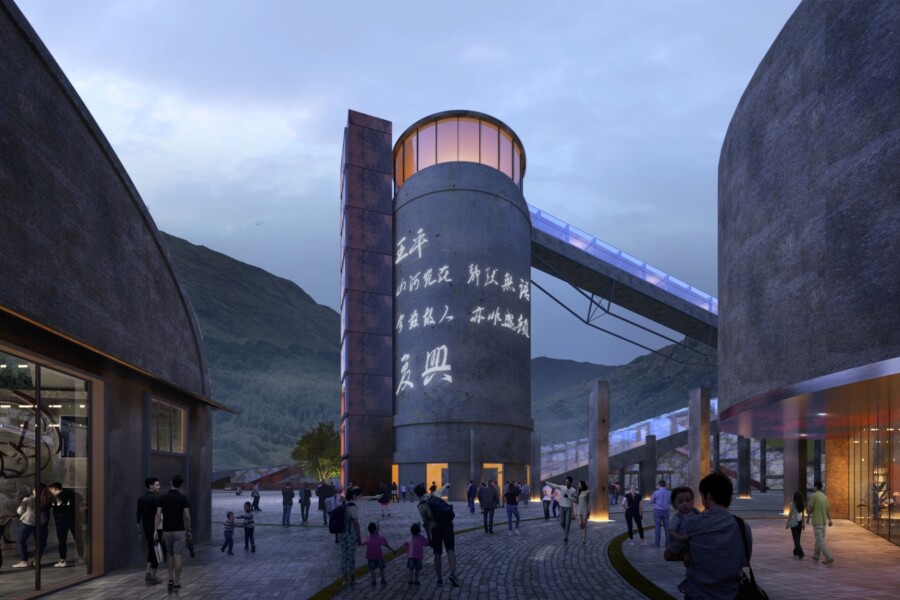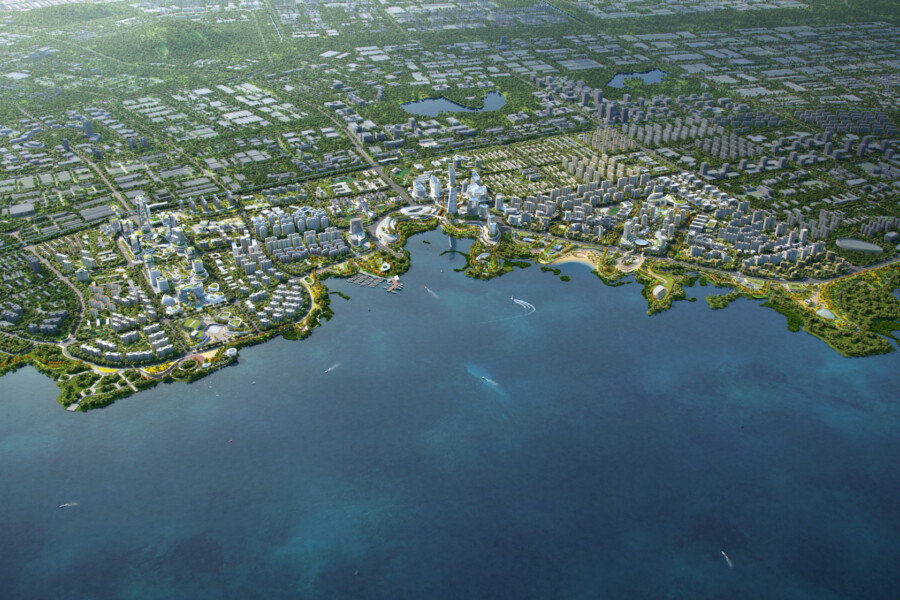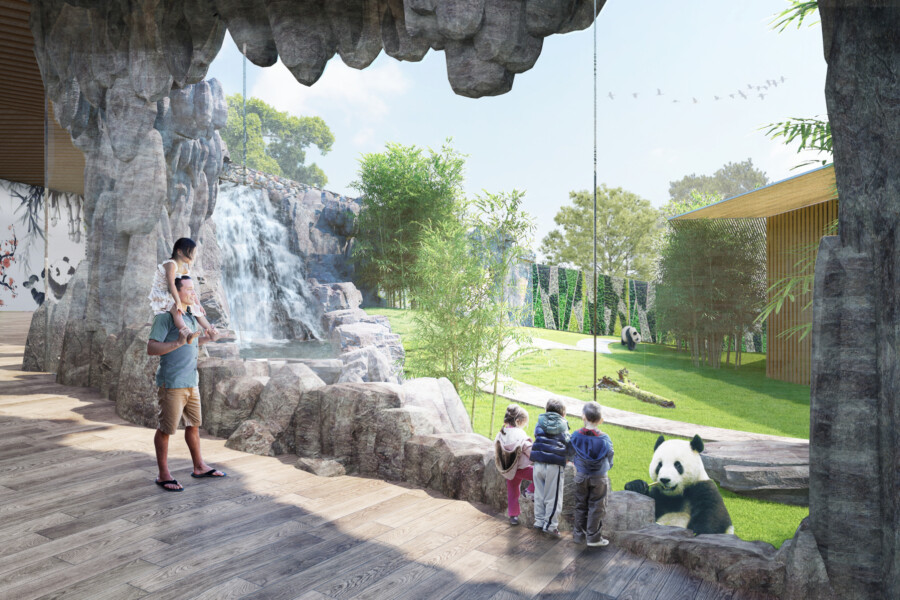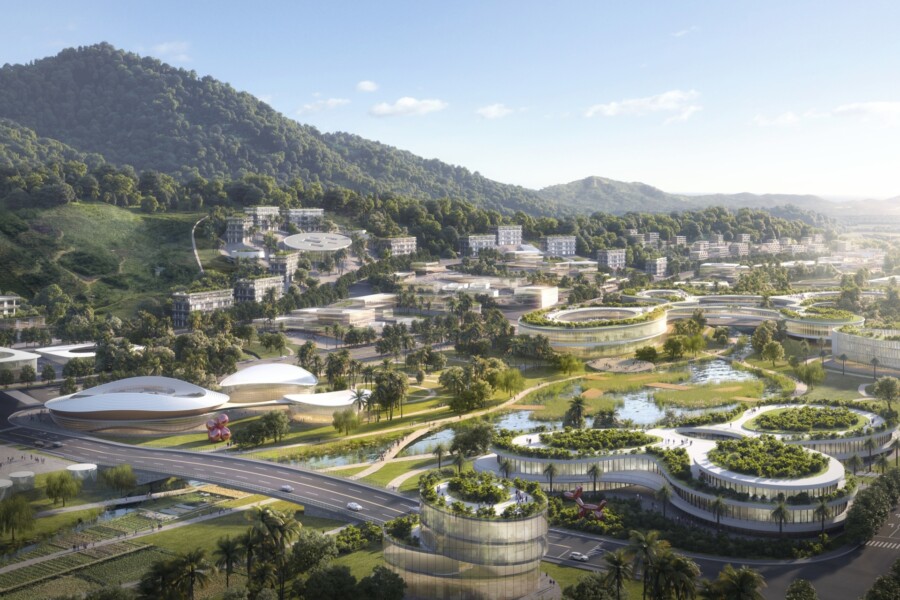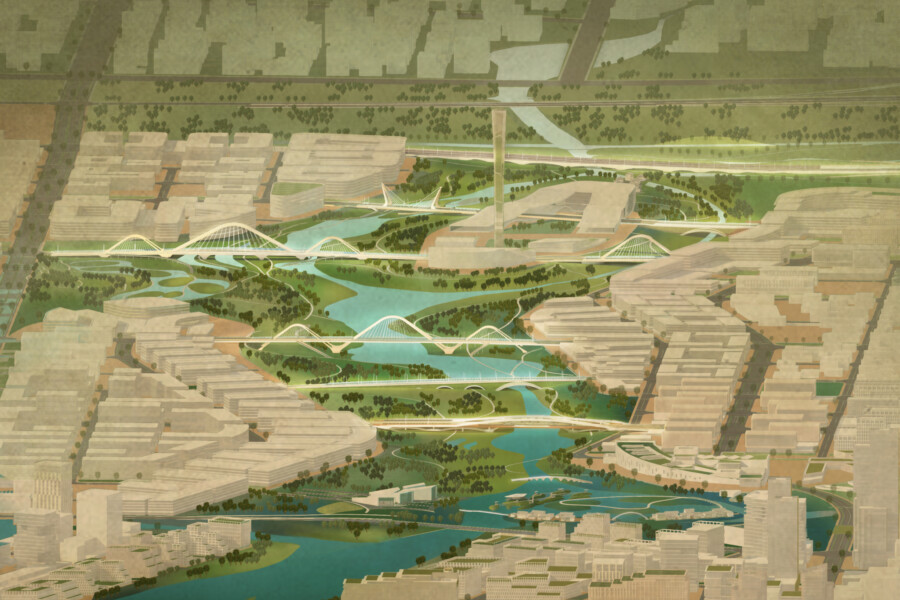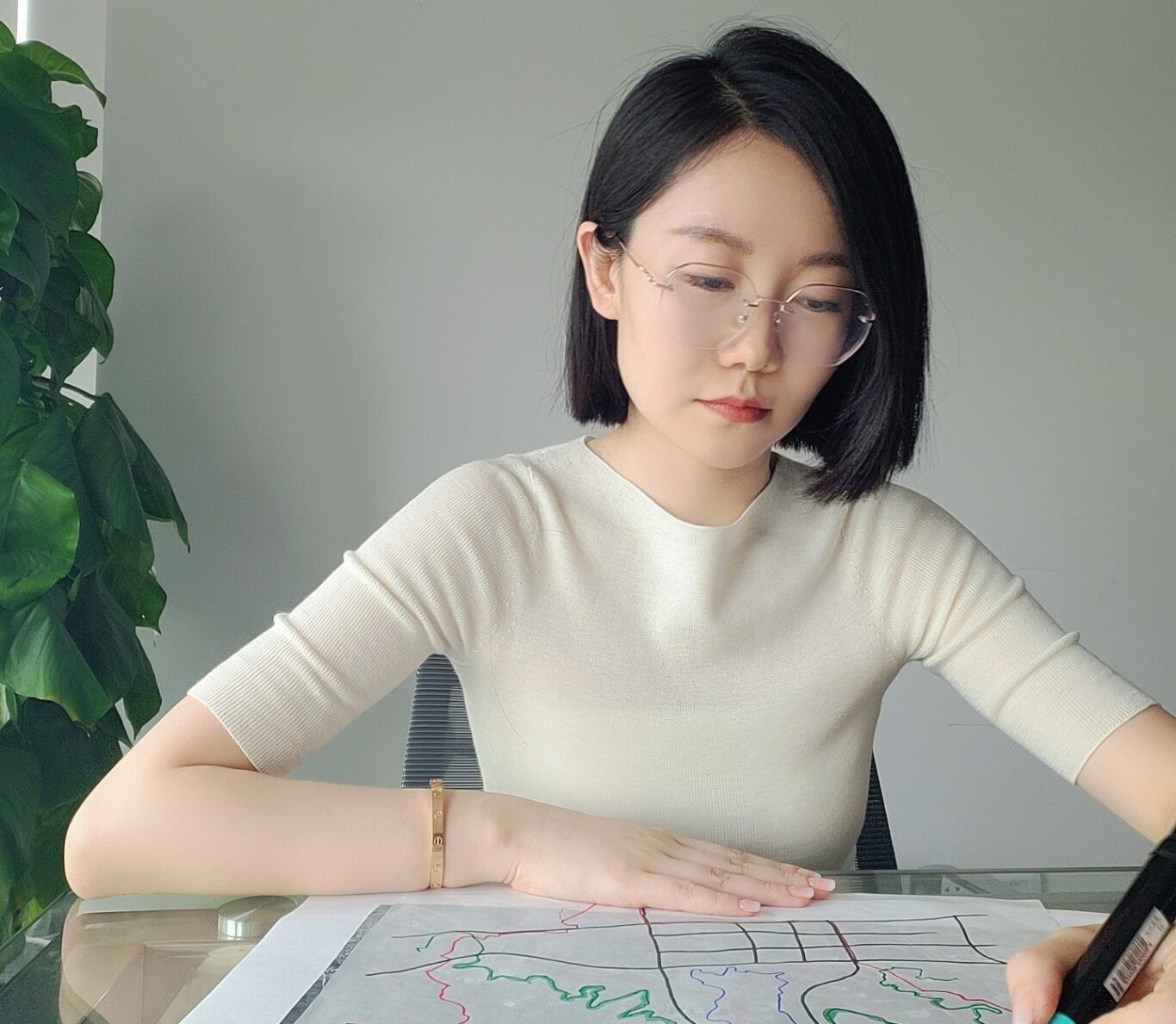
People profile: Associate Director in Shanghai, Yichun Xu
Yichun Xu joined Chapman Taylor in 2018 and has become an instrumental part of our competition-winning masterplanning team in Shanghai, raising our profile significantly in China. In this profile, she talks us through her background and explains her approach to developing innovative ideas to address challenging urban design contexts.
Can you tell me a bit about your upbringing?
I grew up in Nanjing. My mum was an adult education teacher and my dad worked in the chemical industry. My dad taught me how to be a respectable leader. When I was a girl, I remember that my mum told me to keep learning - to never stop. There are always opportunities. Most of my extended family were also teachers, so growing up in that environment probably shaped me a bit. I was quite studious at school.
I was also influenced by my grandpa who is a well-known calligraphy artist in his home town. Every inch of the walls in his house was covered by Chinese calligraphic poems or the Sansui landscape paintings he drew. Also, the courtyard was full of potted landscape bonsais that he had created. I was immersed in this quite traditional Chinese aesthetic when I grew up, which definitely had a positive influence on me and maybe that’s the reason I love to integrate Chinese culture and art into the projects I work on.
I came to understand through my studies that I was quite gifted at anything related to shapes, especially solid geometry deductions. I also enjoyed looking at problems and using logical thinking. With all of these combined, I started to consider that maybe the design field, especially architecture, might be a suitable career for me.
Where did you continue your studies?
Nanjing University is the top University in China and was my dream university when I was young. Unfortunately, at the time the university wasn’t offering an architectural qualification and urban planning was the closest available major. So I chose it even though it was a five-year course. It had an incredibly broad curriculum incorporating geology, history, transportation, urban economics, architecture and drawing. It’s a multi-discipline subject and it’s been useful to my current role at Chapman Taylor as urban design is based on urban planning. However, while studying, I did feel a bit of a void inside of me. Urban planning is more about the system and less about the design – it’s quite macro and focuses on the big picture. I did hope I could have the opportunity to mix design with my knowledge of the system.
Did you remain in Nanjing after that?
After graduating I was accepted on a Postgraduate course at the University of Michigan in the US. I wanted to experience a different culture and learn more about other approaches to the design world in order to develop my vision and ideas further. I chose to study urban design as this is in between urban planning and architecture.
It was an interesting introduction to Western culture. I would say that there is a bit more critical thinking – people are a bit more sceptical of things that they are taught. It helped me consider looking at urban design from a traditional, conventional viewpoint, as well as integrating more modern thinking and when finding solutions to always try and “think outside of the box”.
After my Postgrad, I moved to New York and worked in a boutique architectural studio – OBRA Architects. It was a very artistic environment. They owned a model shop and there was always a smell of burning wood from the laser cutter. I worked on projects of vastly different scales, from small (including furniture design) to as large as a 600 km2 project. Working on a small scale made me cultivate a detail-oriented attitude towards my work that I’ve been able to carry with me.
In 2015, I returned to China and moved to Shanghai. I started working for a French urban design company. I was promoted quite quickly to director, which pushed me to acquire many new skills besides design, such as learning more about managing the whole process, some marketing, a little bit of finance, and honing my presentation technique. I had to manage projects right from before the bidding stage through to receiving payment and to future opportunities. I got to take ownership and deal directly with clients – to see the bigger picture.
One of the big differences between working on projects in the US and China is the timeframe. In the US, the design stage tends to last quite a long time. For example, I worked on a school architecture project that involved producing a dozen handmade models for only the schematic design stage, which lasted for a year. In China, an urban design competition typically lasts between two and three months, and you have to design an area 100 times bigger. There isn’t much difference in working hours, though. I worked long hours in the US and I do now in Shanghai – I’m often told I’m a bit of a workaholic!
Why did you join Chapman Taylor?
As I always like to be challenged and learn new things, I joined Chapman Taylor to work on higher-level projects. I remember that I joined Chapman Taylor on International Women’s Day in 2018, which felt significant to me, as a female designer. I started on the Xiong’an Rongdong Masterplan project, and through that project, I learned about the design process, the team and the design value system of Chapman Taylor. I’m quite lucky as I worked with Chris Lanksbury from the start and learned continuously during this journey. The second project I worked on was Daxing Western Area Urban Design - I was the project manager and design leader. I followed the design methodology that Chris used in Xiong’an Rongdong and designed the area with similar urban cluster strategies. We won that competition. That was a quite nice start here.
We started to build up a good reputation in Beijing, as the client likes Chris’ designs. We were shortlisted in a fierce competition for Xiong’an Xiongzan Masterplan. It was such a hectic and challenging project as we joined the competition one month later than the other competitors, but with the most sophisticated and feasible design, we won the competition.
After winning the 272km2 Xiong’An Xiongzan masterplan we’ve won other projects in Xiong’an such as the Xiong’an Intercity Express Railway Station Urban Design. The Express Railway is a very important mode of transportation in China.
With more competition wins and our reputation getting stronger throughout China, we have grown our masterplan team and strengthened our expertise. Thanks to the trust in the practice, besides general urban design and masterplanning, we have often been assigned a very challenging project or a project in a completely new field, such as this Express Railway TOD project Jiaxing South Station TOD Urban Design and our first bridge design project Xiong’an boot area 19 bridge project.
There’s a lot of trust in us and our clients know we always produce reliable, high-quality designs with great respect for Chinese culture and people.
How do you get inspiration for your designs?
In every project, the problem that needs to be tackled is unique. The background, the context, the history, the culture, the people who live in and visit the area; everything is different. Our challenge is to identify the most suitable way to create a unique design that meets our client’s objectives. Such as for the recently won project Hainan Yangpu Coastal Urban Design (https://www.chapmantaylor.com/news/chapman-taylor-wins-design-competition-for-yangpu-bay-hainan-china), the design was inspired by local salt production history and we rebuilt the symbiotic system between humans and nature. If we’re able to reflect the memory of the past into the design that’s always very pleasing. In the early stages of the project, when considering the design concept, we do look to the past and try and tie a thread to the future.
Also, alongside respect for history and culture, we are very keen to respect nature. In another one of our competition-winning designs, One Line and Four Mines in Beijing (https://www.chapmantaylor.com/projects/one-line-and-four-mines), we’ve regenerated the towns chained along a cargo train route in a historical coal district, using multiple ecological remediation methods and transformed the area into a dynamic and ecological tourist destination. In every project, we always respect nature and try to rebuild the close relationship between people and nature. We always say nature is the best designer and very frequently we use ecology to form the structure of the design.
What more can you share about your projects and the design process?
For the design process, most of our projects are won during fierce competition rounds that last 2-3 months. We need to ensure the best design result while delivering the project on time. Usually, we have a learning/research stage, concept stage, masterplan design stage along with transportation design stage, an architecture design stage along with landscape design stage, then finally we move on to the production stage. Usually, we can’t switch this sequence, or it will impact the result. Planning a project’s resource wisely is a very important job and we need to keep adjusting the plan to ensure satisfactory delivery.
A skilled project manager needs to be able to make a quick decision with the most amount of forward-thinking. Luckily, we have a resilient team that works like a Navy SEAL, we’re used to adjusting our design direction and workforce quickly and everyone supports each other along the way. When a challenge occurs, we often form a 3-person team comprising of a particular specialism, to tackle the difficulty efficiently and with the necessary expertise.
The projects that we work on are quite complex, so we have to acquire a lot of knowledge in a short space of time at the beginning of each project. There are many layers of thinking. For example, technical, aesthetic, functional and cultural. You really have to reach into every layer of thinking in order to produce innovative and feasible ideas for the design. Such as in the Land of Giant Panda (https://www.chapmantaylor.com/projects/land-of-giant-pandas) project, we quickly chewed several books and consulted with experts, learned all the zoo design regulations, studied the Giant panda lifestyle and the research demands to create the most satisfactory design result in only three weeks. I find the complexity fascinating and we need to keep learning most of the time. The best solution occurs only when you have formed the knowledge of the associated subjects.
Besides the complexity of the projects, we’ve worked on projects of different scales. As a masterplan team we usually work on an area of thousands of hectares, however we just won an architecture competition of just half a hectare, to design apartments that will improve the quality of life of the ‘dispatchers’ or 'controllers', who work on China’s railways. (
Baoshan residential project for China Railway Corporation link). This is a smaller-scale project but no less important to us than huge macro urban designs. For each piece of work, we have to adjust the team to best fit the project and achieve its bespoke design goals.
Design-wise, we provide solutions that integrate different perspectives. It’s not just the urban planning part, we also need to have plans for the landscape design, transportation design and architectural design, and on some projects, such as the Express Railway station, even the interior design. For Transport Oriented Development projects we map out the proposed circulation and weave all of this together into a detailed document.
For the final production stage, each project requires a series of deliverables – physical models, animation and multimedia, plus 10 to 20 renderings, A0 panels a presentation document and usually a booklet of around 400 pages. For our recently won competition, Sanya Jiyang East Urban Design (https://www.chapmantaylor.com/news/chapman-taylor-wins-masterplan-design-competition-for-80km-sanya-jiyang-area-in-hainan-province-china), we submitted a physical model of about 75sqm. We usually have multiple deadlines every day. It’s definitely not easy work!
What’s the future direction for you and Chapman Taylor in China?
I have been in charge of the Masterplan department since 2021. As my role changed, I needed to free up time to work on the management of the whole process, but still as we’re a design-oriented team, project design and management are my priorities. During the past year, we strengthened the team and made it more united and more multidisciplinary. We’ve built a mixed team that consists of urban planners, architects, industry, transport and landscape experts. Also, for the past year, we have doubled our winning ratio although we worked on twice as many projects with the same size team.
We want to keep on winning competitions and cement our reputation as a leading architectural studio. Usually, an influential urban design competition means that a city or the central government want to develop a geographic area which generates future opportunities. By winning, we are introduced to planning departments and added to architectural registers which means that we will be consulted for future projects. It opens up opportunities for the entire practice, especially for our architectural team.
I'm looking forward to the future, in particular the challenge of the unknown. Our team is always excited when we receive a brief for a project in a new context or new work scope. We’re continuing to learn from Director Chris Lanksbury – everyone here has a lot of respect for him and his work ethic. He’s drafted ten masterplan design principles, which we will keep reflecting in our work so that our value system can be promoted more widely.
As Chris says, our best project is always the next project!
Can you tell me a bit about your upbringing?
I grew up in Nanjing. My mum was an adult education teacher and my dad worked in the chemical industry. My dad taught me how to be a respectable leader. When I was a girl, I remember that my mum told me to keep learning - to never stop. There are always opportunities. Most of my extended family were also teachers, so growing up in that environment probably shaped me a bit. I was quite studious at school.
I was also influenced by my grandpa who is a well-known calligraphy artist in his home town. Every inch of the walls in his house was covered by Chinese calligraphic poems or the Sansui landscape paintings he drew. Also, the courtyard was full of potted landscape bonsais that he had created. I was immersed in this quite traditional Chinese aesthetic when I grew up, which definitely had a positive influence on me and maybe that’s the reason I love to integrate Chinese culture and art into the projects I work on.
I came to understand through my studies that I was quite gifted at anything related to shapes, especially solid geometry deductions. I also enjoyed looking at problems and using logical thinking. With all of these combined, I started to consider that maybe the design field, especially architecture, might be a suitable career for me.
Where did you continue your studies?
Nanjing University is the top University in China and was my dream university when I was young. Unfortunately, at the time the university wasn’t offering an architectural qualification and urban planning was the closest available major. So I chose it even though it was a five-year course. It had an incredibly broad curriculum incorporating geology, history, transportation, urban economics, architecture and drawing. It’s a multi-discipline subject and it’s been useful to my current role at Chapman Taylor as urban design is based on urban planning. However, while studying, I did feel a bit of a void inside of me. Urban planning is more about the system and less about the design – it’s quite macro and focuses on the big picture. I did hope I could have the opportunity to mix design with my knowledge of the system.
Did you remain in Nanjing after that?
After graduating I was accepted on a Postgraduate course at the University of Michigan in the US. I wanted to experience a different culture and learn more about other approaches to the design world in order to develop my vision and ideas further. I chose to study urban design as this is in between urban planning and architecture.
It was an interesting introduction to Western culture. I would say that there is a bit more critical thinking – people are a bit more sceptical of things that they are taught. It helped me consider looking at urban design from a traditional, conventional viewpoint, as well as integrating more modern thinking and when finding solutions to always try and “think outside of the box”.
After my Postgrad, I moved to New York and worked in a boutique architectural studio – OBRA Architects. It was a very artistic environment. They owned a model shop and there was always a smell of burning wood from the laser cutter. I worked on projects of vastly different scales, from small (including furniture design) to as large as a 600 km2 project. Working on a small scale made me cultivate a detail-oriented attitude towards my work that I’ve been able to carry with me.
In 2015, I returned to China and moved to Shanghai. I started working for a French urban design company. I was promoted quite quickly to director, which pushed me to acquire many new skills besides design, such as learning more about managing the whole process, some marketing, a little bit of finance, and honing my presentation technique. I had to manage projects right from before the bidding stage through to receiving payment and to future opportunities. I got to take ownership and deal directly with clients – to see the bigger picture.
One of the big differences between working on projects in the US and China is the timeframe. In the US, the design stage tends to last quite a long time. For example, I worked on a school architecture project that involved producing a dozen handmade models for only the schematic design stage, which lasted for a year. In China, an urban design competition typically lasts between two and three months, and you have to design an area 100 times bigger. There isn’t much difference in working hours, though. I worked long hours in the US and I do now in Shanghai – I’m often told I’m a bit of a workaholic!
Why did you join Chapman Taylor?
As I always like to be challenged and learn new things, I joined Chapman Taylor to work on higher-level projects. I remember that I joined Chapman Taylor on International Women’s Day in 2018, which felt significant to me, as a female designer. I started on the Xiong’an Rongdong masterplan project, and through that project, I learned about the design process, the team and the design value system of Chapman Taylor. I’m quite lucky as I worked with Chris Lanksbury from the start and learned continuously during this journey. The second project I worked on was Daxing Western Area urban design - I was the project manager and design leader. I followed the design methodology that Chris used in Xiong’an Rongdong and designed the area with similar urban cluster strategies. We won that competition. That was a quite nice start here.
We started to build up a good reputation in Beijing, as the client likes Chris’ designs. We were shortlisted in a fierce competition for Xiong’an Xiongzan masterplan. It was such a hectic and challenging project as we joined the competition one month later than the other competitors, but with the most sophisticated and feasible design, we won the competition.
After winning the 272km2 Xiong’An Xiongzan masterplan we’ve won other projects in Xiong’an such as the Xiong’an Intercity Express Railway Station urban design. The Express Railway is a very important mode of transportation in China.
With more competition wins and our reputation getting stronger throughout China, we have grown our masterplan team and strengthened our expertise. Thanks to the trust in the practice, besides general urban design and masterplanning, we have often been assigned a very challenging project or a project in a completely new field, such as this Jiaxing South Station TOD urban design and our first bridge design project, Xiong’an 19 bridges project.
There’s a lot of trust in us and our clients know we always produce reliable, high-quality designs with great respect for Chinese culture and people.
How do you get inspiration for your designs?
In every project, the problem that needs to be tackled is unique. The background, the context, the history, the culture, the people who live in and visit the area; everything is different. Our challenge is to identify the most suitable way to create a unique design that meets our client’s objectives. Such as for the recently won project Hainan Yangpu Coastal Urban Design, the design was inspired by local salt production history and we rebuilt the symbiotic system between humans and nature. If we’re able to reflect the memory of the past into the design that’s always very pleasing. In the early stages of the project, when considering the design concept, we do look to the past and try and tie a thread to the future.
Also, alongside respect for history and culture, we are very keen to respect nature. In another one of our competition-winning designs, One Line and Four Mines in Beijing, we’ve regenerated the towns chained along a cargo train route in a historical coal district, using multiple ecological remediation methods and transformed the area into a dynamic and ecological tourist destination. In every project, we always respect nature and try to rebuild the close relationship between people and nature. We always say nature is the best designer and very frequently we use ecology to form the structure of the design.
What more can you share about your projects and the design process?
For the design process, most of our projects are won during fierce competition rounds that last 2-3 months. We need to ensure the best design result while delivering the project on time. Usually, we have a learning/research stage, concept stage, masterplan design stage along with transportation design stage, an architecture design stage along with landscape design stage, then finally we move on to the production stage. Usually, we can’t switch this sequence, or it will impact the result. Planning a project’s resource wisely is a very important job and we need to keep adjusting the plan to ensure satisfactory delivery.
A skilled project manager needs to be able to make a quick decision with the most amount of forward-thinking. Luckily, we have a resilient team that works like a Navy SEAL, we’re used to adjusting our design direction and workforce quickly and everyone supports each other along the way. When a challenge occurs, we often form a 2-5 person team comprising of a particular specialism, to tackle the difficulty efficiently and with the necessary expertise.
The projects that we work on are quite complex, so we have to acquire a lot of knowledge in a short space of time at the beginning of each project. There are many layers of thinking. For example, technical, aesthetic, functional and cultural. You really have to reach into every layer of thinking in order to produce innovative and feasible ideas for the design. For example, in the Land of Giant Panda project, we quickly chewed several books and consulted with experts, learned all the zoo design regulations, studied the Giant panda lifestyle and the research demands to create the most satisfactory design result in only three weeks. I find the complexity fascinating and we need to keep learning most of the time. The best solution occurs only when you have formed the knowledge of the associated subjects.
Besides the complexity of the projects, we’ve worked on projects of different scales. As a masterplan team we usually work on an area of thousands of hectares, however we just won an architecture competition of just half a hectare, to design Dispatcher Apartments in Shanghai, that will improve the quality of life of the ‘dispatchers’ or 'controllers', who work on China’s railways. This is a smaller-scale project but no less important to us than huge macro urban designs. For each piece of work, we have to adjust the team to best fit the project and achieve its bespoke design goals.
Design-wise, we provide solutions that integrate different perspectives. It’s not just the urban planning part, we also need to have plans for the landscape design, transportation design and architectural design, and on some projects, such as the Express Railway station, even the interior design. For Transport Oriented Development projects we map out the proposed circulation and weave all of this together into a detailed document.
For the final production stage, each project requires a series of deliverables – physical models, animation and multimedia, plus 10 to 20 renderings, A0 panels a presentation document and usually a booklet of around 400 pages. For our recently won competition, Sanya Jiyang East Urban Design, we submitted a physical model of about 75sqm. We usually have multiple deadlines every day. It’s quite stressful but also very rewarding when the hard work pays off with first prize.
What’s the future direction for you and Chapman Taylor in China?
I have been in charge of the masterplan department since 2021. As my role changed, I needed to free up time to work on the management of the whole process, but still as we’re a design-oriented team, project design and management are my priorities. During the past year, we strengthened the team and made it more united and more multidisciplinary. We’ve built a mixed team that consists of urban planners, architects, industry, transport and landscape experts. Also, for the past year, we have doubled our winning ratio although we worked on twice as many projects with the same size team.
We want to keep on winning competitions and cement our reputation as a leading architectural studio. Usually, an influential urban design competition means that a city or the central government want to develop a geographic area which generates future opportunities. By winning, we are introduced to planning departments and added to architectural registers which means that we will be consulted for future projects. It opens up opportunities for the entire practice, especially for our architectural team.
I'm looking forward to the future, in particular the challenge of the unknown. Our team is always excited when we receive a brief for a project in a new context or new work scope. We’re continuing to learn from Director Chris Lanksbury – everyone here has a lot of respect for him and his work ethic. He's drafted ten masterplan design principles, which we will keep reflecting in our work so that our value system can be promoted more widely.
As Chris says, our best project is always the next project!
Did you remain in Nanjing after that?
After graduating I was accepted on a Postgraduate course at the University of Michigan in the US. I wanted to experience a different culture and learn more about other approaches to the design world in order to develop my vision and ideas further. I chose to study urban design as this is in between urban planning and architecture.
It was an interesting introduction to Western culture. I would say that there is a bit more critical thinking – people are a bit more sceptical of things that they are taught. It helped me consider looking at urban design from a traditional, conventional viewpoint, as well as integrating more modern thinking and when finding solutions to always try and “think outside of the box”.
After my Postgrad, I moved to New York and worked in a boutique architectural studio – OBRA Architects. It was a very artistic environment. They owned a model shop and there was always a smell of burning wood from the laser cutter. I worked on projects of vastly different scales, from small (including furniture design) to as large as a 600 km2 project. Working on a small scale made me cultivate a detail-oriented attitude towards my work that I’ve been able to carry with me.
In 2015, I returned to China and moved to Shanghai. I started working for a French urban design company. I was promoted quite quickly to director, which pushed me to acquire many new skills besides design, such as learning more about managing the whole process, some marketing, a little bit of finance, and honing my presentation technique. I had to manage projects right from before the bidding stage through to receiving payment and to future opportunities. I got to take ownership and deal directly with clients – to see the bigger picture.
One of the big differences between working on projects in the US and China is the timeframe. In the US, the design stage tends to last quite a long time. For example, I worked on a school architecture project that involved producing a dozen handmade models for only the schematic design stage, which lasted for a year. In China, an urban design competition typically lasts between two and three months, and you have to design an area 100 times bigger. There isn’t much difference in working hours, though. I worked long hours in the US and I do now in Shanghai – I’m often told I’m a bit of a workaholic!
Why did you join Chapman Taylor?
As I always like to be challenged and learn new things, I joined Chapman Taylor to work on higher-level projects. I remember that I joined Chapman Taylor on International Women’s Day in 2018, which felt significant to me, as a female designer. I started on the Xiong’an Rongdong masterplan project, and through that project, I learned about the design process, the team and the design value system of Chapman Taylor. I’m quite lucky as I worked with Chris Lanksbury from the start and learned continuously during this journey. The second project I worked on was Daxing Western Area urban design - I was the project manager and design leader. I followed the design methodology that Chris used in Xiong’an Rongdong and designed the area with similar urban cluster strategies. We won that competition. That was a quite nice start here.
We started to build up a good reputation in Beijing, as the client likes Chris’ designs. We were shortlisted in a fierce competition for Xiong’an Xiongzan masterplan. It was such a hectic and challenging project as we joined the competition one month later than the other competitors, but with the most sophisticated and feasible design, we won the competition.
After winning the 272km2 Xiong’An Xiongzan masterplan we’ve won other projects in Xiong’an such as the Xiong’an Intercity Express Railway Station urban design. The Express Railway is a very important mode of transportation in China.
With more competition wins and our reputation getting stronger throughout China, we have grown our masterplan team and strengthened our expertise. Thanks to the trust in the practice, besides general urban design and masterplanning, we have often been assigned a very challenging project or a project in a completely new field, such as this Jiaxing South Station TOD urban design and our first bridge design project, Xiong’an 19 bridges project.
There’s a lot of trust in us and our clients know we always produce reliable, high-quality designs with great respect for Chinese culture and people.
How do you get inspiration for your designs?
In every project, the problem that needs to be tackled is unique. The background, the context, the history, the culture, the people who live in and visit the area; everything is different. Our challenge is to identify the most suitable way to create a unique design that meets our client’s objectives. Such as for the recently won project Hainan Yangpu Coastal Urban Design, the design was inspired by local salt production history and we rebuilt the symbiotic system between humans and nature. If we’re able to reflect the memory of the past into the design that’s always very pleasing. In the early stages of the project, when considering the design concept, we do look to the past and try and tie a thread to the future.
Also, alongside respect for history and culture, we are very keen to respect nature. In another one of our competition-winning designs, One Line and Four Mines in Beijing, we’ve regenerated the towns chained along a cargo train route in a historical coal district, using multiple ecological remediation methods and transformed the area into a dynamic and ecological tourist destination. In every project, we always respect nature and try to rebuild the close relationship between people and nature. We always say nature is the best designer and very frequently we use ecology to form the structure of the design.
What more can you share about your projects and the design process?
For the design process, most of our projects are won during fierce competition rounds that last 2-3 months. We need to ensure the best design result while delivering the project on time. Usually, we have a learning/research stage, concept stage, masterplan design stage along with transportation design stage, an architecture design stage along with landscape design stage, then finally we move on to the production stage. Usually, we can’t switch this sequence, or it will impact the result. Planning a project’s resource wisely is a very important job and we need to keep adjusting the plan to ensure satisfactory delivery.
A skilled project manager needs to be able to make a quick decision with the most amount of forward-thinking. Luckily, we have a resilient team that works like a Navy SEAL, we’re used to adjusting our design direction and workforce quickly and everyone supports each other along the way. When a challenge occurs, we often form a 2-5 person team comprising of a particular specialism, to tackle the difficulty efficiently and with the necessary expertise.
The projects that we work on are quite complex, so we have to acquire a lot of knowledge in a short space of time at the beginning of each project. There are many layers of thinking. For example, technical, aesthetic, functional and cultural. You really have to reach into every layer of thinking in order to produce innovative and feasible ideas for the design. For example, in the Land of Giant Panda project, we quickly chewed several books and consulted with experts, learned all the zoo design regulations, studied the Giant panda lifestyle and the research demands to create the most satisfactory design result in only three weeks. I find the complexity fascinating and we need to keep learning most of the time. The best solution occurs only when you have formed the knowledge of the associated subjects.
Besides the complexity of the projects, we’ve worked on projects of different scales. As a masterplan team we usually work on an area of thousands of hectares, however we just won an architecture competition of just half a hectare, to design Dispatcher Apartments in Shanghai, that will improve the quality of life of the ‘dispatchers’ or 'controllers', who work on China’s railways. This is a smaller-scale project but no less important to us than huge macro urban designs. For each piece of work, we have to adjust the team to best fit the project and achieve its bespoke design goals.
Design-wise, we provide solutions that integrate different perspectives. It’s not just the urban planning part, we also need to have plans for the landscape design, transportation design and architectural design, and on some projects, such as the Express Railway station, even the interior design. For Transport Oriented Development projects we map out the proposed circulation and weave all of this together into a detailed document.
For the final production stage, each project requires a series of deliverables – physical models, animation and multimedia, plus 10 to 20 renderings, A0 panels a presentation document and usually a booklet of around 400 pages. For our recently won competition, Sanya Jiyang East Urban Design, we submitted a physical model of about 75sqm. We usually have multiple deadlines every day. It’s quite stressful but also very rewarding when the hard work pays off with first prize.
What’s the future direction for you and Chapman Taylor in China?
I have been in charge of the masterplan department since 2021. As my role changed, I needed to free up time to work on the management of the whole process, but still as we’re a design-oriented team, project design and management are my priorities. During the past year, we strengthened the team and made it more united and more multidisciplinary. We’ve built a mixed team that consists of urban planners, architects, industry, transport and landscape experts. Also, for the past year, we have doubled our winning ratio although we worked on twice as many projects with the same size team.
We want to keep on winning competitions and cement our reputation as a leading architectural studio. Usually, an influential urban design competition means that a city or the central government want to develop a geographic area which generates future opportunities. By winning, we are introduced to planning departments and added to architectural registers which means that we will be consulted for future projects. It opens up opportunities for the entire practice, especially for our architectural team.
I'm looking forward to the future, in particular the challenge of the unknown. Our team is always excited when we receive a brief for a project in a new context or new work scope. We’re continuing to learn from Director Chris Lanksbury – everyone here has a lot of respect for him and his work ethic. He's drafted ten masterplan design principles, which we will keep reflecting in our work so that our value system can be promoted more widely.
As Chris says, our best project is always the next project!
Why did you join Chapman Taylor?
As I always like to be challenged and learn new things, I joined Chapman Taylor to work on higher-level projects. I remember that I joined Chapman Taylor on International Women’s Day in 2018, which felt significant to me, as a female designer. I started on the Xiong’an Rongdong masterplan project, and through that project, I learned about the design process, the team and the design value system of Chapman Taylor. I’m quite lucky as I worked with Chris Lanksbury from the start and learned continuously during this journey. The second project I worked on was Daxing Western Area urban design - I was the project manager and design leader. I followed the design methodology that Chris used in Xiong’an Rongdong and designed the area with similar urban cluster strategies. We won that competition. That was a quite nice start here.
We started to build up a good reputation in Beijing, as the client likes Chris’ designs. We were shortlisted in a fierce competition for Xiong’an Xiongzan masterplan. It was such a hectic and challenging project as we joined the competition one month later than the other competitors, but with the most sophisticated and feasible design, we won the competition.
After winning the 272km2 Xiong’An Xiongzan masterplan we’ve won other projects in Xiong’an such as the Xiong’an Intercity Express Railway Station urban design. The Express Railway is a very important mode of transportation in China.
With more competition wins and our reputation getting stronger throughout China, we have grown our masterplan team and strengthened our expertise. Thanks to the trust in the practice, besides general urban design and masterplanning, we have often been assigned a very challenging project or a project in a completely new field, such as this Jiaxing South Station TOD urban design and our first bridge design project, Xiong’an 19 bridges project.
There’s a lot of trust in us and our clients know we always produce reliable, high-quality designs with great respect for Chinese culture and people.
How do you get inspiration for your designs?
In every project, the problem that needs to be tackled is unique. The background, the context, the history, the culture, the people who live in and visit the area; everything is different. Our challenge is to identify the most suitable way to create a unique design that meets our client’s objectives. Such as for the recently won project Hainan Yangpu Coastal Urban Design, the design was inspired by local salt production history and we rebuilt the symbiotic system between humans and nature. If we’re able to reflect the memory of the past into the design that’s always very pleasing. In the early stages of the project, when considering the design concept, we do look to the past and try and tie a thread to the future.
Also, alongside respect for history and culture, we are very keen to respect nature. In another one of our competition-winning designs, One Line and Four Mines in Beijing, we’ve regenerated the towns chained along a cargo train route in a historical coal district, using multiple ecological remediation methods and transformed the area into a dynamic and ecological tourist destination. In every project, we always respect nature and try to rebuild the close relationship between people and nature. We always say nature is the best designer and very frequently we use ecology to form the structure of the design.
What more can you share about your projects and the design process?
For the design process, most of our projects are won during fierce competition rounds that last 2-3 months. We need to ensure the best design result while delivering the project on time. Usually, we have a learning/research stage, concept stage, masterplan design stage along with transportation design stage, an architecture design stage along with landscape design stage, then finally we move on to the production stage. Usually, we can’t switch this sequence, or it will impact the result. Planning a project’s resource wisely is a very important job and we need to keep adjusting the plan to ensure satisfactory delivery.
A skilled project manager needs to be able to make a quick decision with the most amount of forward-thinking. Luckily, we have a resilient team that works like a Navy SEAL, we’re used to adjusting our design direction and workforce quickly and everyone supports each other along the way. When a challenge occurs, we often form a 2-5 person team comprising of a particular specialism, to tackle the difficulty efficiently and with the necessary expertise.
The projects that we work on are quite complex, so we have to acquire a lot of knowledge in a short space of time at the beginning of each project. There are many layers of thinking. For example, technical, aesthetic, functional and cultural. You really have to reach into every layer of thinking in order to produce innovative and feasible ideas for the design. For example, in the Land of Giant Panda project, we quickly chewed several books and consulted with experts, learned all the zoo design regulations, studied the Giant panda lifestyle and the research demands to create the most satisfactory design result in only three weeks. I find the complexity fascinating and we need to keep learning most of the time. The best solution occurs only when you have formed the knowledge of the associated subjects.
Besides the complexity of the projects, we’ve worked on projects of different scales. As a masterplan team we usually work on an area of thousands of hectares, however we just won an architecture competition of just half a hectare, to design Dispatcher Apartments in Shanghai, that will improve the quality of life of the ‘dispatchers’ or 'controllers', who work on China’s railways. This is a smaller-scale project but no less important to us than huge macro urban designs. For each piece of work, we have to adjust the team to best fit the project and achieve its bespoke design goals.
Design-wise, we provide solutions that integrate different perspectives. It’s not just the urban planning part, we also need to have plans for the landscape design, transportation design and architectural design, and on some projects, such as the Express Railway station, even the interior design. For Transport Oriented Development projects we map out the proposed circulation and weave all of this together into a detailed document.
For the final production stage, each project requires a series of deliverables – physical models, animation and multimedia, plus 10 to 20 renderings, A0 panels a presentation document and usually a booklet of around 400 pages. For our recently won competition, Sanya Jiyang East Urban Design, we submitted a physical model of about 75sqm. We usually have multiple deadlines every day. It’s quite stressful but also very rewarding when the hard work pays off with first prize.
What’s the future direction for you and Chapman Taylor in China?
I have been in charge of the masterplan department since 2021. As my role changed, I needed to free up time to work on the management of the whole process, but still as we’re a design-oriented team, project design and management are my priorities. During the past year, we strengthened the team and made it more united and more multidisciplinary. We’ve built a mixed team that consists of urban planners, architects, industry, transport and landscape experts. Also, for the past year, we have doubled our winning ratio although we worked on twice as many projects with the same size team.
We want to keep on winning competitions and cement our reputation as a leading architectural studio. Usually, an influential urban design competition means that a city or the central government want to develop a geographic area which generates future opportunities. By winning, we are introduced to planning departments and added to architectural registers which means that we will be consulted for future projects. It opens up opportunities for the entire practice, especially for our architectural team.
I'm looking forward to the future, in particular the challenge of the unknown. Our team is always excited when we receive a brief for a project in a new context or new work scope. We’re continuing to learn from Director Chris Lanksbury – everyone here has a lot of respect for him and his work ethic. He's drafted ten masterplan design principles, which we will keep reflecting in our work so that our value system can be promoted more widely.
As Chris says, our best project is always the next project!
What more can you share about your projects and the design process?
For the design process, most of our projects are won during fierce competition rounds that last 2-3 months. We need to ensure the best design result while delivering the project on time. Usually, we have a learning/research stage, concept stage, masterplan design stage along with transportation design stage, an architecture design stage along with landscape design stage, then finally we move on to the production stage. Usually, we can’t switch this sequence, or it will impact the result. Planning a project’s resource wisely is a very important job and we need to keep adjusting the plan to ensure satisfactory delivery.
A skilled project manager needs to be able to make a quick decision with the most amount of forward-thinking. Luckily, we have a resilient team that works like a Navy SEAL, we’re used to adjusting our design direction and workforce quickly and everyone supports each other along the way. When a challenge occurs, we often form a 2-5 person team comprising of a particular specialism, to tackle the difficulty efficiently and with the necessary expertise.
The projects that we work on are quite complex, so we have to acquire a lot of knowledge in a short space of time at the beginning of each project. There are many layers of thinking. For example, technical, aesthetic, functional and cultural. You really have to reach into every layer of thinking in order to produce innovative and feasible ideas for the design. For example, in the Land of Giant Panda project, we quickly chewed several books and consulted with experts, learned all the zoo design regulations, studied the Giant panda lifestyle and the research demands to create the most satisfactory design result in only three weeks. I find the complexity fascinating and we need to keep learning most of the time. The best solution occurs only when you have formed the knowledge of the associated subjects.
Besides the complexity of the projects, we’ve worked on projects of different scales. As a masterplan team we usually work on an area of thousands of hectares, however we just won an architecture competition of just half a hectare, to design Dispatcher Apartments in Shanghai, that will improve the quality of life of the ‘dispatchers’ or 'controllers', who work on China’s railways. This is a smaller-scale project but no less important to us than huge macro urban designs. For each piece of work, we have to adjust the team to best fit the project and achieve its bespoke design goals.
Design-wise, we provide solutions that integrate different perspectives. It’s not just the urban planning part, we also need to have plans for the landscape design, transportation design and architectural design, and on some projects, such as the Express Railway station, even the interior design. For Transport Oriented Development projects we map out the proposed circulation and weave all of this together into a detailed document.
For the final production stage, each project requires a series of deliverables – physical models, animation and multimedia, plus 10 to 20 renderings, A0 panels a presentation document and usually a booklet of around 400 pages. For our recently won competition, Sanya Jiyang East Urban Design, we submitted a physical model of about 75sqm. We usually have multiple deadlines every day. It’s quite stressful but also very rewarding when the hard work pays off with first prize.
What’s the future direction for you and Chapman Taylor in China?
I have been in charge of the masterplan department since 2021. As my role changed, I needed to free up time to work on the management of the whole process, but still as we’re a design-oriented team, project design and management are my priorities. During the past year, we strengthened the team and made it more united and more multidisciplinary. We’ve built a mixed team that consists of urban planners, architects, industry, transport and landscape experts. Also, for the past year, we have doubled our winning ratio although we worked on twice as many projects with the same size team.
We want to keep on winning competitions and cement our reputation as a leading architectural studio. Usually, an influential urban design competition means that a city or the central government want to develop a geographic area which generates future opportunities. By winning, we are introduced to planning departments and added to architectural registers which means that we will be consulted for future projects. It opens up opportunities for the entire practice, especially for our architectural team.
I'm looking forward to the future, in particular the challenge of the unknown. Our team is always excited when we receive a brief for a project in a new context or new work scope. We’re continuing to learn from Director Chris Lanksbury – everyone here has a lot of respect for him and his work ethic. He's drafted ten masterplan design principles, which we will keep reflecting in our work so that our value system can be promoted more widely.
As Chris says, our best project is always the next project!
